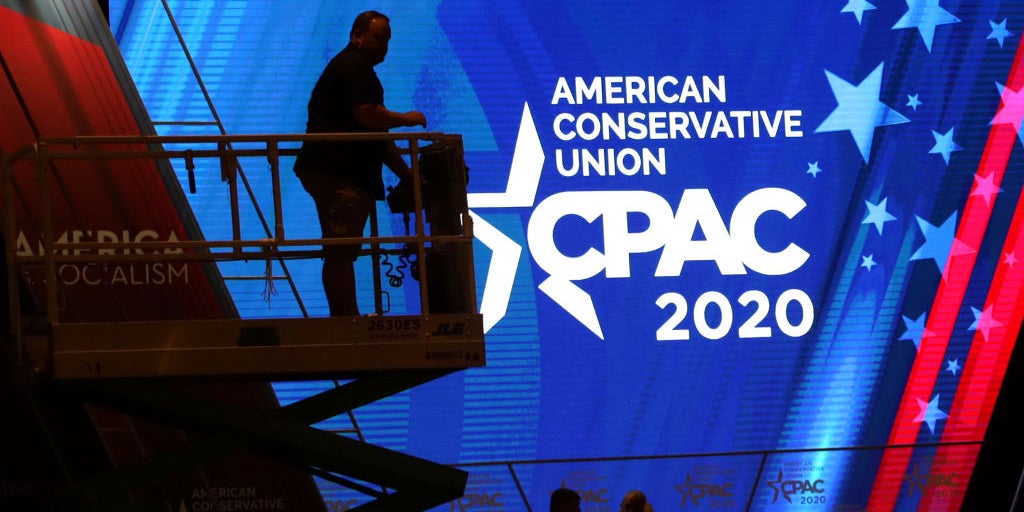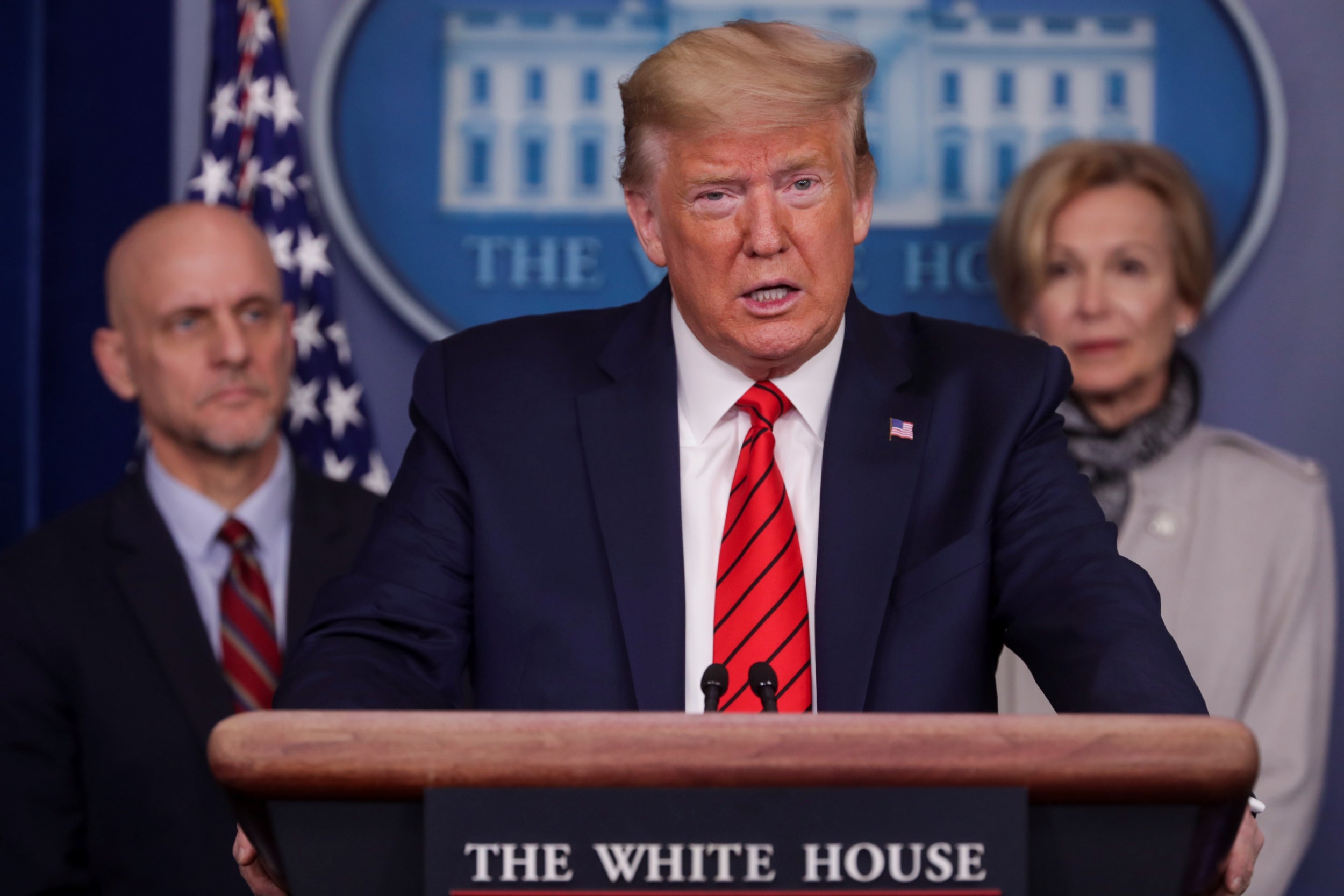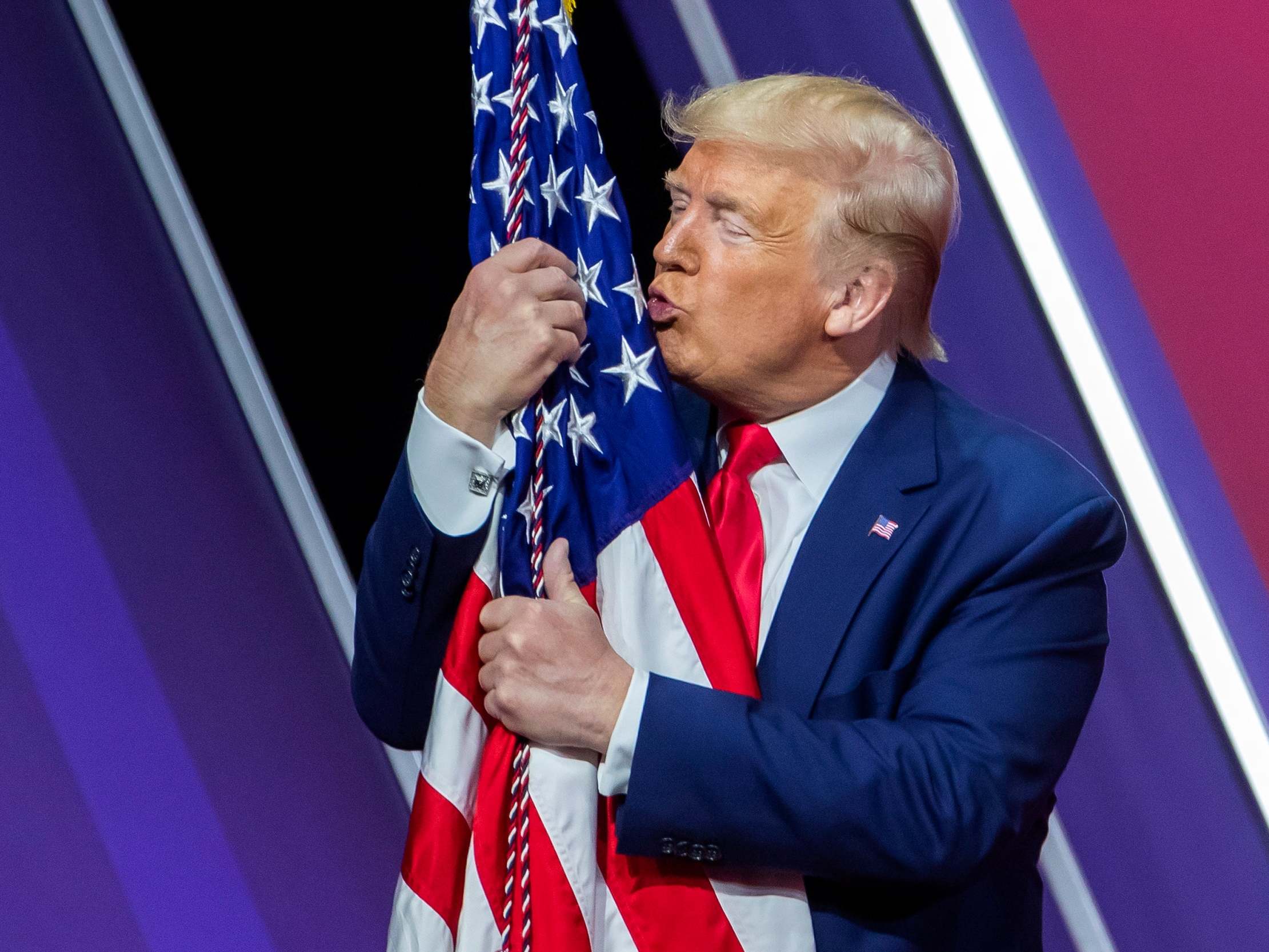Coronavirus: CPAC under fire for virus response that exposed thousands
‘For the thousands who attended CPAC, they communicated what was essentially fake news, giving the impression that everything was fine, when there is no way they could have known,’ says attendee

Your support helps us to tell the story
From reproductive rights to climate change to Big Tech, The Independent is on the ground when the story is developing. Whether it's investigating the financials of Elon Musk's pro-Trump PAC or producing our latest documentary, 'The A Word', which shines a light on the American women fighting for reproductive rights, we know how important it is to parse out the facts from the messaging.
At such a critical moment in US history, we need reporters on the ground. Your donation allows us to keep sending journalists to speak to both sides of the story.
The Independent is trusted by Americans across the entire political spectrum. And unlike many other quality news outlets, we choose not to lock Americans out of our reporting and analysis with paywalls. We believe quality journalism should be available to everyone, paid for by those who can afford it.
Your support makes all the difference.The New Jersey doctor with flu-like symptoms had quickly become the patient. With a laboratory-confirmed case of Covid-19, he was whisked away to isolation and asked the questions that experts knew were essential to slowing the spread of the novel coronavirus in its first weeks in the United States: where have you been, and with whom have you been in contact?
The doctor had just spent three days in a Maryland suburb of the nation’s capital, from 26-29 February, where he paid for exclusive access to VIPs at the annual Conservative Political Action Conference (CPAC). He had snapped selfies with Republican members of Congress. He had attended invitation-only meals with Republican mega-donors. And he had shaken hands with CPAC’s leader, who the following day glad-handed President Donald Trump as he took the stage.
But after interviewing the man by phone as he lay in a hospital bed in New Jersey, asking about his contacts and travel, state health officials there announced on 7 March that they would monitor only a handful of people, including the doctor’s immediate family members, for signs of the infection. Officials warned no CPAC attendees that they were particularly at risk, according to statements and interviews.
The next day, however, members of Congress began revealing that they not only had encountered the 55-year-old doctor but had spent time with him. One said he and several staff members had “sustained” contact with the doctor. Another had held the doctor’s phone to take pictures. Five lawmakers in all announced they would self-quarantine, and Trump faced questions about possible secondhand exposure.
With the US response having catapulted into a new phase of large-scale commercial shutdowns and social distancing, the handling of the potential exposure at CPAC, where Trump’s then-chief of staff played down the threat of the virus, is a powerful example of the lack of urgency and poor coordination among agencies that has characterised the early US response. The approach stands in stark contrast to aggressive actions taken by some countries that slowed the spread of the virus in its early days. In Singapore, for instance, public health officials not only interviewed the sick but also obtained patients’ travel itineraries and used security camera footage to track their movements to help identify every person possible with whom they had incidental contact.
“For the thousands who attended CPAC, they communicated what was essentially fake news, giving the impression that everything was fine, when there is no way they could have known,” said conference attendee Raheem Kassam, a former Breitbart editor who now leads the conservative publication National Pulse. “Even if there’s not another single positive test result because of this, how many have been carrying it or never got tested because of the assurances that were given?”
On March 8, a day after the New Jersey doctor’s positive test result was announced and as the extent of the doctor’s contacts at CPAC were becoming clear, officials said public health workers had begun to locate and notify conference attendees. The Centers for Disease Control and Prevention (CDC) “confirmed his attendance and is working with CPAC to notify all the attendees,” New Jersey Health Commissioner Judith Persichilli told reporters.
In truth, no such effort was undertaken by the CDC, New Jersey or Maryland, according to officials in both states and with the CDC, who pointed to one another as the responsible party. They did not publicize the name of the doctor, who spoke on the condition of anonymity for this story to preserve his privacy.
Alerted by the doctor himself, political operatives who organised the conference undertook the responsibility themselves, attempting to identify attendees who might have been at risk.
In a process that took days, CPAC organisers pieced together his movements, learning belatedly that he had attended a crowded kickoff event. They also persuaded the doctor to review photos on his iPhone he had taken from the event, two organisers said, including a photo the doctor had taken with Rep. Matt Gaetz, R-Fla.
By the time they alerted Gaetz, he was on Air Force One with the president after having spent two days at Trump’s Mar-a-Lago resort with members of the first family.
Ultimately, the organisers notified close to 100 attendees, according to Matt Schlapp, chairman of the American Conservative Union, the lobbying group that puts on CPAC.
On Tuesday, Washington DC officials announced that another man who had attended the conference, a 23-year-old Washington resident, had also tested positive. In addition, a Spanish politician who attended CPAC has tested positive, although he may have contracted the virus after leaving.
The New Jersey doctor remained hospitalised Wednesday, for a 14th consecutive day. He was recently upgraded from intensive care and is expected to recover. He declined to comment on what information he relayed to state health officials, saying he was not yet prepared to recall specific details.
Still coughing frequently while speaking with a Washington Post reporter by phone, he said he was less concerned about who did what or when, and mostly wanted people to think about what precautions they could take going forward.

“Every American should take this virus seriously,” said the doctor, who faced anti-Semitic attacks online after his name surfaced in a limited number of media accounts. “I think people who needed to get notified did – that’s it.”
Contact tracing is a long-established practice for stopping the spread of infection by identifying and monitoring people who may have been exposed to an infected individual. It allows health officials to encourage those most at risk to enter isolation and, if necessary, access treatment as early as possible. The process was crucial to containing Severe Acute Respiratory Syndrome, or Sars, after it appeared in China in 2002, and it was pivotal to halting outbreaks of Ebola in Africa in 2014 and 2018.
On March 1, a day after CPAC concluded, US Health and Human Services Secretary Alex Azar called contact tracing “the basic blocking and tackling” that public health officials were engaged in to prevent the spread of coronavirus.
It was a moment when containment of the novel coronavirus in the United States still seemed possible.
Known cases appeared geographically isolated, with most centred around a nursing home near Seattle and others near military bases in California that held evacuees from China. In New York, the first case was announced that day: a woman who had recently travelled from Iran. In the Washington DC area, as in 47 states, there were still no confirmed cases, although that would soon change. Over the next five days, 17 states would announce cases.
Although his case was not yet confirmed, on March 4 the doctor was admitted to a hospital in Englewood, New Jersey, with flu-like symptoms. Health officials learned that four days before CPAC, he had attended a bar mitzvah at a Jewish temple in New Rochelle, New York. A lawyer who attended that celebration had just tested positive.
On 7 March, Schlapp’s phone rang as he had lunch with his family at a restaurant in Northern Virginia. On the other end of the line was the doctor, delivering the news that he, too, had tested positive.
“I quickly felt the information was accurate and that we needed to act,” recalled Schlapp, a frequent guest on Fox News. “It wasn’t just people who had bought tickets, but it was members of Congress, members of the media, the White House, thousands of people – including some who don’t agree with us – who come to our event. I felt everyone needed to be alerted.”

In New Jersey, the case was publicly revealed later that day in a conference call with reporters, although the connection to CPAC was not announced. Persichilli, the state health commissioner, announced that the infected person was a Bergen County resident who had been hospitalised for three days.
The “patient was also at an out-of-state conference,” Persichilli said, referring to CPAC, “so this investigation of contacts will include interstate communications.”
Donna Leusner, director of communications for the New Jersey Department of Health, said in an interview that state officials followed the still-evolving CDC guidelines for determining high-risk contacts of infected coronavirus patients. According to the guidelines, such individuals include someone who is an intimate partner of or has cared for a laboratory-confirmed infected patient in a home setting.
Leusner said it was not, and still is not, the state’s practice to track down people who had less exposure to an infected individual. She said that what little information had been gleaned about the patient’s attendance at CPAC, and the fact that he becomes symptomatic on 27 February was “passed off” to Maryland officials who were better positioned to determine if further monitoring was required.
Maryland officials, however, interpreted the handoff differently, according to interviews. In Maryland, public health officials say they try to trace an infected person’s contacts from “tip to tail,” including any likely contacts out of state. So when New Jersey did not provide names, they took it at face value that there were none.
“That is a New Jersey resident, and so the contact tracing for that individual, it’s done by the state of New Jersey,” Fran Phillips, Maryland’s deputy secretary for public health services and the state’s point person for coronavirus response, told The Post. “If there are Marylanders named, individuals named as a result of that contact tracing, we would know that. That has not been the case.”
Schlapp said he was relieved when hours after the doctor’s call on 7 March, Maryland health officials told him CPAC attendees would not need to self-quarantine.
“The conclusion from the state of Maryland was that they didn’t get the sense that there had been an outbreak; they didn’t see a need to quarantine, which was great,” Schlapp said.
In a statement that evening, Maryland Republican Gov. Larry Hogan encouraged CPAC attendees to monitor their health and contact their provider if they experience flu- or cold-like symptoms.
“We are providing this update not to unnecessarily raise alarm, but in the interest of full transparency and out of an abundance of caution,” his statement read.

Even so, CPAC organizers and the doctor began alerting attendees. And the next day brought a cascade of announcements and confusion that undercut the idea that attendees should not be concerned.
On Sunday 8 March, Sen. Ted Cruz, R-Texas, said in a statement that he “briefly interacted” with the infected person and would self-quarantine at his Texas home “out of an abundance of caution.” Rep. Paul Gosar, R-Ariz., tweeted that he and three staff members were going under self-quarantine “after sustained contact at CPAC” with the person who has the virus. The White House said repeatedly that Trump was not experiencing symptoms.
On a call with reporters that day, Persichilli was asked about the CPAC case and said that the “CDC confirmed his attendance and is working with CPAC to notify all the attendees.”
A CDC spokeswoman, however, later described the agency’s role differently, saying in an email to The Post that Maryland and New Jersey were in charge of taking the lead on notifications.
CPAC organizers also issued a statement saying that Maryland state health workers had “screened thousands of employees” at the Gaylord National Resort and Convention Centre, where the event took place and reported that “not a single person has reported an unusual illness. Thus, the Dept. of Health is not restricting the movements” of resort employees.
Maryland health officials did not correct that statement for days but now say it was inaccurate.
Instead, it was actually Marriott International, which operates the Gaylord, that evaluated some employees’ health. According to two employees, that consisted mostly of a staff meeting in which the topic of possible exposure was discussed, and employees were told to report any spike in temperature.
Marriott spokeswoman Allison Sitch did not respond to requests for comment. CNBC reported last week that Sitch wrote in an email that the hotel performed enhanced cleaning after learning of the infected attendee. But the network quoted Sitch saying the screenings attributed to state health officials did not occur. “It is my understanding that no screens of either people or facilities has been performed at the property,” she wrote. County health officials also told The Post they had not conducted such screenings.
The lack of a more thorough and transparent tracing process led attendees to begin sleuthing for whether they had been exposed to the infected attendee.
Kassam, the former Brietbart editor, had been home for days following CPAC and struggling with flu-like symptoms when he heard a fellow attendee had tested positive. He soon realised he had greeted Gosar and talked on a panel with him shortly after the lawmaker had interacted with the infected attendee.
Kassam said he began to worry he could have contracted the virus. He found the messages from state officials and CPAC organizers discordant. And he became incensed by what he viewed as an effort by Schlapp and CPAC to play down the possibility that attendees such as himself had been exposed, including Schlapp criticising the 8 March Washington Examiner story that said Trump may have had secondhand exposure.

“Dear Exam. ‘friends,’ “ Schlapp tweeted. “I have consistently said that I had incidental contact w this attendee, but have no symptoms. We have Zero new cases. The POTUS is healthy. You will need to decide if you want to report the facts or incite panic. I choose the former.”
The next morning, Schlapp followed up, tweeting: “Woke up today and all the Schlapp’s are healthy. Same for entire @CPACstaff ... We have no symptoms. Stay calm USA! Check your temp, if elevated call your doc.”
Kassam used the list of the lawmakers who had announced they would self-quarantine, including the incoming White House chief of staff, Rep. Mark Meadows, R-N.C., and Rep. Douglas Collins, R-Ga., to deduce that the infected person must have been in the VIP area near speakers on one particular day of the conference.
Kassam tweeted a list of others who had probably been close by, including White House adviser Kellyanne Conway, Republican National Committee Chairwoman Ronna McDaniel and Gaetz, who just days earlier had donned a gas mask in the Capitol in a stunt many saw as making light of the coronavirus threat.
After seeing the tweet, Gaetz questioned if he, too, had been exposed. Gaetz had attended a party at Mar-a-Lago, sitting near the president’s son Donald Trump Jr. and his girlfriend, Kimberly Guilfoyle, on the night the news broke. He also had interacted with a delegation from Brazil, one of whom later tested positive.
In an interview, Gaetz said he saw his name in Kassam’s tweet and decided to contact CPAC.
By then, Schlapp and other executives had already spent two days reaching out to the White House, members of Congress and people who, like the doctor, had purchased “gold”-level CPAC tickets. The expensive tickets gave the group access to, among other places, the VIP area near where speakers waited to address the crowd. McDaniel, the RNC chair, was at times in the area, and Kassam, who was not, were both later tested and found to be negative.
CPAC staff tried to assure the congressman that he had not been with the doctor. But to make sure, they again contacted the doctor. During a back-and-forth over phone calls and text messages, CPAC leaders realised they had been mistaken, according to people familiar with the exchange. One image made clear that Gaetz had taken the doctor’s phone and held his arm outstretched to take a selfie of the two.
A staffer for Gaetz reached the congressman just as he had settled into Air Force One to return to Washington with the president. For the rest of the flight, Gaetz tried to keep his distance from everyone onboard.
In his ensuing days of self-quarantine, Gaetz told the Spectator that in touching the doctor’s phone, he felt he “might as well have licked his toilet seat.” In a phone interview from his home Monday, Gaetz said he still feels that way: “A phone is a place someone sheds virus.”
With the help of the White House physician’s office, Gaetz was tested at Walter Reed National Military Medical Centre and found negative. Even so, he remained home as much as possible until 14 days after his contact with the doctor.
Asked to evaluate the way public health agencies handled the contact tracing after CPAC, where the virus had been within a handshake of the president, Gaetz said he had not been privy to how the agencies made decisions.
“I don’t know,” he said. “They never contacted me.”
The Washington Post
Join our commenting forum
Join thought-provoking conversations, follow other Independent readers and see their replies
Comments